Pregnant Women and Flu Vaccination, Internet Panel Survey, United States, November 2015

Influenza (flu) can cause severe illness among pregnant women and result in preterm labor and increased risk for hospitalization and even death (1).
The best way for pregnant women to protect themselves from the flu is to get a flu shot (1). Centers for Disease Control and Prevention (CDC), the American College of Obstetricians and Gynecologists, the American College of Nurse Midwives, and the American Academy of Family Physicians recommend flu shots for all women who are or will be pregnant during the flu season, regardless of trimester (1–3).
Infants younger than 6 months are at high risk of severe complications from the flu, but they are too young to be vaccinated (4). Infants whose mothers get the flu shot while pregnant have a lower risk of flu illness and influenza-related hospitalizations during the first 6 months of life (1-2,5–6).
Vaccination coverage among pregnant women increased in 2009-10, but has been relatively stable since that time.
- Before the 2009-10 season, flu vaccination coverage among women pregnant at the time of interview was below 30%, as measured by the National Health Interview Survey (NHIS) and the Behavioral Risk Factor Surveillance System (BRFSS) (7–8).
- During the 2009-10 flu season, 38.0% of women pregnant during the flu season were vaccinated before or during pregnancy as measured by BRFSS, 32.1% as measured by the National 2009 H1N1 Flu Survey (NHFS), and 47.1% of women with a live birth as measured by the Pregnancy Risk Assessment Monitoring System (PRAMS)‡(8–10).
- Vaccination coverage has been relatively stable since the 2012-13 flu season. Vaccination coverage among women vaccinated before or during pregnancy measured by the Internet panel surveys was 43.9% in the 2010-11 flu season, 43.2% in the 2011-12 flu season, 50.5% in the 2012-13 flu season, 52.2% in the 2013-14 flu season, and 50.3% in the 2014-15 influenza season (11).
To estimate flu vaccine coverage by early November 2015, CDC analyzed data on influenza vaccination from an Internet panel survey conducted October 29 through November 5, 2015 among women who were pregnant any time since August 2015. The results of this survey provide information for use in vaccination campaigns during National Influenza Vaccination Week (December 6 -12, 2015). This report provides early flu season (early November) estimates of vaccine uptake by pregnant women. Final 2015-16 flu season vaccination coverage estimates for pregnant women will become available after the end of the flu season.
Key Findings
- As of early November 2015, flu vaccination coverage before and during pregnancy among pregnant women was 40.2%, similar to 2013-14 early season vaccination coverage (43.5%).
- In the previous two flu seasons, vaccination coverage increased by approximately 7-12 percentage points from the early season to the end of the season.
- Non-Hispanic black pregnant women had the lowest flu vaccination coverage (32.9%) compared to the other three racial/ethnic groups (non-Hispanic white: 39.9%, Hispanic: 44.6%, and non-Hispanic other: 46.4%).
- Most women (97.8%) reported visiting a doctor or other medical professional at least once since July 1, 2015. Among these women, 61.6% reported receiving a recommendation for and offer of vaccination from a doctor or other medical professional, 15.0% received only a recommendation for and no offer of vaccination, and 23.4% did not receive a recommendation for flu vaccination which were similar to the proportions in November 2014 (59.5%, 15.3% and 25.1%, respectively).
- Women who received a recommendation for and an offer of vaccination from a doctor or other medical professional were more likely to be vaccinated.
- They were almost three times more likely to be vaccinated as women who received only a recommendation for vaccination but no offer of vaccination (58.8% vs. 20.1%) and eight times more likely to be vaccinated as women who did not receive a recommendation for vaccination (58.8% vs.7.1%)
- Vaccination coverage among those who received provider recommendation and offer for vaccination (58.8%) or among those who received recommendation only (20.1%) were lower compared to November 2014 (65.2% and 25.5%, respectively).
Conclusion/Recommendation:
- Health care providers are encouraged to continue to strongly recommend and offer flu shots to pregnant women throughout the flu season to prevent the flu.
Who Was Vaccinated?
Coverage by Age Group
- Younger pregnant women (18-24 years) had a vaccination coverage (37.9%) similar to pregnant women 25-34 years (40.0%) but lower than women 35-49 years (44.3%).
- Vaccination coverage in early November 2015 was similar for pregnant women 18-24 years in early November 2014 (37.9% vs.35.9%), but lower for women 25-34 years old (40.0% vs. 45.5%) and women 35-49 years old (44.3 % vs. 50.0%).
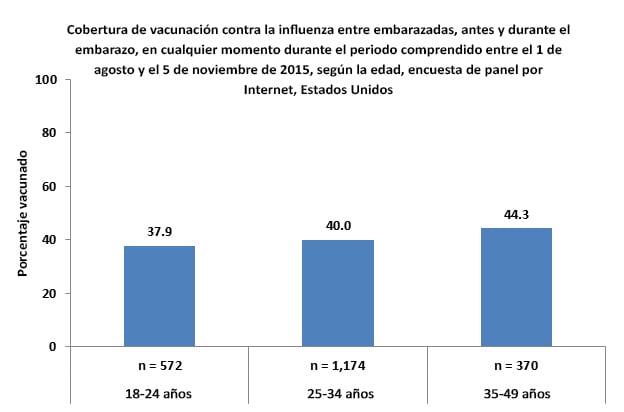
Coverage by Race/Ethnicity
- Flu vaccination coverage among non-Hispanic black women was 32.9%, lower than among non-Hispanic white women (39.9%), Hispanic women (44.6%) and women of non-Hispanic other race/ethnicity (46.4%).
- Compared to the 2014 early season estimates, coverage in early November 2015 was lower among non-Hispanic black women (32.9% vs. 38.6%), and similar for women in the other three racial/ethnic groups (Non-Hispanic white: 39.9% vs. 43.0%; Hispanic: 44.6% vs. 47.9%; non-Hispanic other: 46.4% vs. 42.9%).

Coverage by Education
- Vaccination coverage was lower among pregnant women with a high school diploma or less (33.9%) or some college (36.4%) compared with women with a college degree (44.9%) or more than a college degree (48.4%).
- Compared to the 2014 early season estimates, coverage was lower in early November 2015 for women with more than a college degree (48.4% vs. 56.5%). Coverage for women in the other educational groups was similar in early November 2015 and early November 2014.
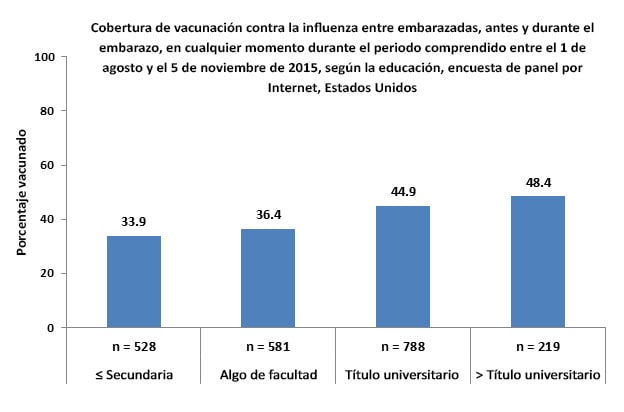
Coverage by Type of Medical Insurance
- Pregnant women who reported having only private/military insurance during pregnancy had higher vaccination coverage (43.7%) than pregnant women who reported having any type of public medical insurance (37.0%) and who reported not having insurance (31.6%).
- Less than one in twenty-five (3.6%) pregnant women reported not having medical insurance.
- These estimates are similar to the results from early November 2014 (46.2%, 41.1% and 29.4%, respectively).
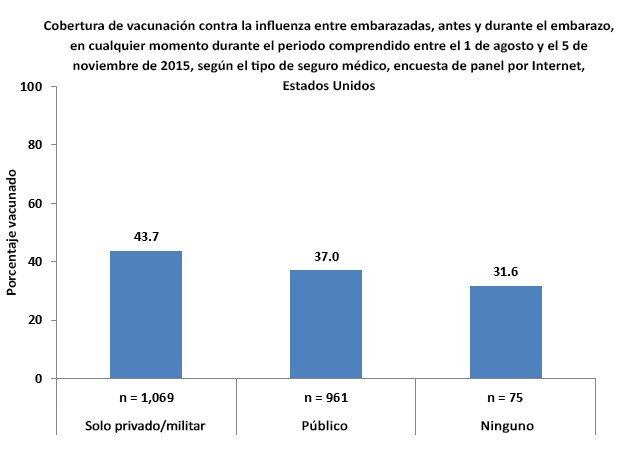
Coverage by Other High-Risk Conditions§
- Women with a high-risk condition (in addition to pregnancy) that increases the risk of severe flu had higher vaccination coverage (44.3%) than women with no additional high-risk conditions (37.1%).
- Compared to the early November 2014 survey, coverage in the early November 2015 survey was lower among women with high-risk conditions other than pregnancy (44.3% vs. 49.5%), and similar to coverage among women without additional high-risk conditions (37.1% vs. 39.8%).
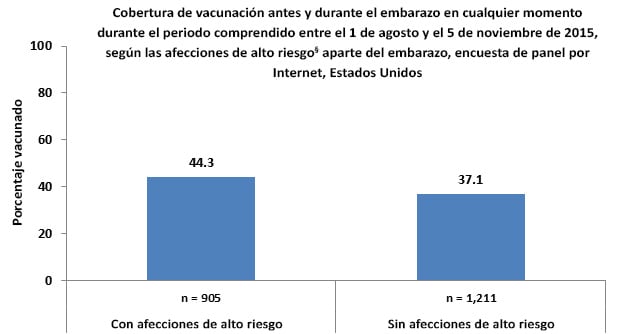
Coverage by Health Care Provider Recommendation and Offer
- Most women (98.1%) reported visiting a doctor or other medical professional at least once since July 1, 2015. Among these women, 61.6% reported receiving a recommendation for and offer of flu vaccination from a doctor or other medical professional, 15.0% received only a recommendation but were not offered the vaccine, and 23.4% did not receive a recommendation for flu vaccination. These results were similar to the early November 2014 survey.
- Flu vaccination coverage among pregnant women was highest (58.8%) among women who reported their doctor or other medical professional recommended and offered the vaccination.
- 20.1% of pregnant women were vaccinated among those that reported they received only a recommendation for but no offer of vaccination from their doctor or other medical professional.
- Only 7.1% of pregnant women were vaccinated among those that reported they did not receive a recommendation for vaccination from their doctor or other medical professional.
- Vaccination coverage among those who received a provider recommendation and offer of vaccination (58.8%) or among those who received a recommendation only (20.1%) were lower compared to November 2014 (65.2% and 25.5%, respectively).
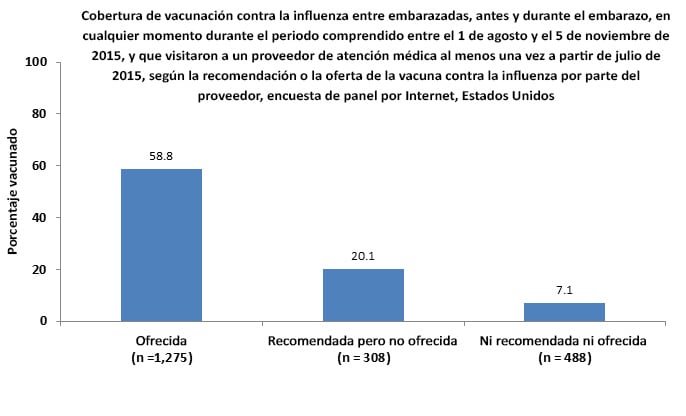
Place of Vaccination
The most commonly reported place for receiving flu vaccination before and during pregnancy among women pregnant early in the flu season was in the office of an obstetrician/gynecologist or midwife (39.7%).
- The reported places for receiving flu vaccination during pregnancy were similar in early November 2015 compared with early November 2014.
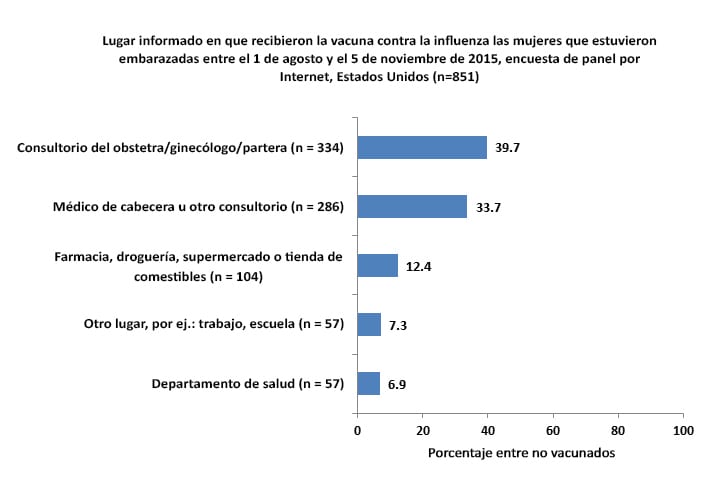
Main Reason for Receiving Vaccination
Respondents who had been vaccinated by the time of the survey were asked to report their main reason for receiving a flu vaccination.
- The most commonly reported reason for receiving a flu vaccination was to protect their baby from flu (36.0%).
- The second most commonly reported reason was to protect themselves from flu (22.9%) and the third most commonly reported reason was that their health-care provider recommended vaccination to them (17.3%).
- The top three main reasons for vaccination were the same in the early November 2014 survey, with proportions of 35.2%, 19.7% and 15.2%, respectively.

Main Reason for Not Receiving Vaccination
Unvaccinated respondents who reported that they did not intend to be vaccinated during this flu season|| were asked their reasons for not receiving or not planning to get one:
- The most commonly reported main reason for not receiving or not planning to get a flu vaccination was belief that the flu vaccine is not effective in preventing the flu (22.1%), higher than the proportion of women who reported this reason in early November 2014 (16.1%).
- The second most commonly reported main reason for not receiving or not planning to get a flu vaccination was concern about getting sick from the flu vaccine (19.5%), higher than the proportion of women who reported this reason in early November 2014 (10.6%).
- The next two main reasons most commonly reported by respondents were concern about possible safety risks to their baby (15.1%) or to themselves (14.0). In November 2014, these proportions were 12.8% and 7.3%, respectively.
- Barriers to vaccination access, such as lack of medical insurance or cost, lack of time, unavailability of the vaccine, and lack of knowledge regarding where to get the vaccine were rarely reported as a main reason for not receiving a flu vaccination.
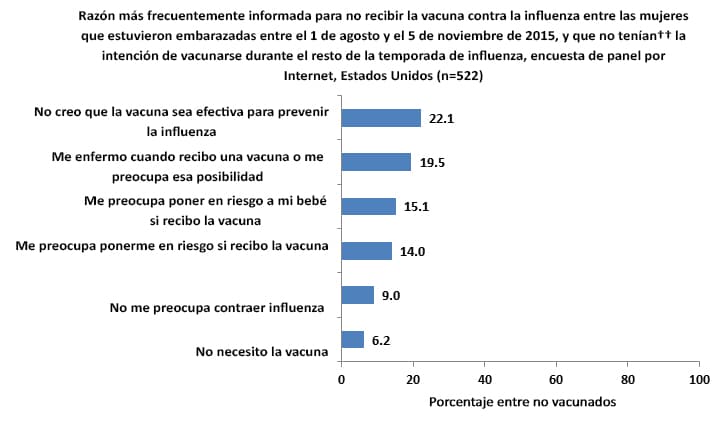
What Can Be Done?
Overall, early 2015-16 season estimates of flu vaccination coverage before or during pregnancy among women pregnant anytime from August 2015 through the time of the survey were similar to the 2014-15 early season estimates. Flu vaccination coverage was highest among pregnant women who reported that their doctor or other medical professional recommended and offered the flu vaccine (58.8%). Coverage estimates were substantially lower among pregnant women who reported receiving only a recommendation without an offer of vaccine (20.1%) and among those who did not receive a recommendation at all (7.1%). Concerns about the effectiveness of the flu vaccine and worry that they might get sick from flu vaccination were the most commonly reported reasons for not receiving a flu vaccination (reported by 22.1% and 19.5% of unvaccinated respondents, respectively). Continued efforts are needed to improve flu vaccination coverage among pregnant women, including:
Increase the proportion of pregnant women who receive a recommendation for and offer of flu vaccination from their doctor or other medical professional:
- All medical professionals should assess the vaccination status of pregnant women at each visit.
- Recommendation from a doctor or other medical professional is strongly associated with vaccination during pregnancy.
- If all pregnant women are assessed for vaccination status and receive both a recommendation for and offer of flu vaccination from their doctor or other medical professional, vaccination coverage should increase.
Continue to vaccinate pregnant women throughout the flu season:
- Over half of the pregnant women in this survey had not been vaccinated as of early November.
- Providers should continue to encourage their unvaccinated patients to receive vaccination as soon as possible, before flu activity increases in their community. Peak flu activity in the United States most often occurs in January or February, but can occur earlier.
- Providers should continue to offer flu shots to unvaccinated pregnant women for the duration of the flu season, even if flu activity has decreased in their community, since more than one type or subtype of flu may cause illness in a single flu season.
Inform pregnant women about the risk of flu infection for them and their infants and about the benefits and risks of flu vaccination:
- Health care providers and immunization programs should provide pregnant women with accurate information on the following topics:
- The risk of the flu and related complications for pregnant women and their babies, including severe illness in pregnant women, preterm labor, and influenza-related illness and hospitalization in their infants;
- The benefits and risks of flu vaccination for mothers and their babies;
- The protection transferred to developing babies by vaccination during pregnancy, since infants younger than 6 months old cannot be vaccinated themselves.
- Information is available at:
- American College of Obstetricians and Gynecologists. Flu shot for pregnant patients: frequently asked questions.
- American College of Obstetricians and Gynecologists. Physician script on influenza immunization during pregnancy. Washington, DC: American College of Obstetricians and Gynecologists; 2013. [946 KB, 2 pages]
- American College of Nurse-Midwifes, Immunization Resources for Providers.
- Pregnant Women and Influenza (Flu)
- Pregnant Women and the Flu Shot: Fact Sheet [509 KB, 2 pages]
- Influenza Vaccination of Pregnant Women: Letter to Providers [260 KB, 2 pages]
- Tips for Mom with support throughout pregnancy through free text messages on topics like prenatal care, baby health, parenting, vaccination, and more.
The November Internet panel survey of pregnant women is designed to provide timely estimates of national flu vaccination coverage and to assess the effectiveness of current vaccination efforts. The follow-up survey in April 2016 will provide end-of-season flu vaccination coverage estimates.
Data Source and Methods
CDC conducted an Internet panel survey from October 29-November 5, 2015, to provide rapid early season estimates of flu vaccination coverage and information on knowledge, attitudes, and behaviors related to flu vaccination among pregnant women not available from other surveys. Women 18–49 years who were pregnant at any time since August 1, 2015, were recruited from SurveySpot, a general population Internet panel. SurveySpot is the same recruitment mechanism that was used in the November 2014 survey. Eligible respondents were either pregnant at the time of the survey or had recently been pregnant. Of 2,223 panel members who were eligible and started the survey, 2,116 (95.2%) completed the online survey. Data were weighted to reflect the age, race/ethnicity, and geographic distribution of the total U.S. population of pregnant women (12–15).
Survey respondents were asked if they had a flu vaccination since July 1, 2015, and if yes, in which month and whether they received the vaccination before, during, or after pregnancy. Pregnancy status questions included whether respondents were currently pregnant at interview or had been pregnant anytime since August 1, 2015. The beginning and end of pregnancy date or expected due date were asked to determine the actual months of pregnancy. Women who reported receiving vaccination since July 1, 2015, and who were vaccinated before or during pregnancy were counted as vaccinated. All respondents were asked if their doctor or other medical professional had recommended or offered the flu vaccine. They were also asked about their attitudes toward and beliefs about flu and flu vaccination.
Weighted analyses were conducted using SAS v9.2 survey procedures. Because the opt-in Internet panel sample was based on those who initially self-selected for participation in the panel rather than a random probability sample, statistical measures such as calculation of confidence intervals and tests of differences were not performed (16). A difference of five percentage points was considered a notable difference.
Sample Demographics
- A total of 2,116 women pregnant any time from August 1-November 5, 2015 were included in the survey, with sample sizes and weighted percentages by demographic variables as follows:
- By age, 572 (28.7%) were 18-24 years, 1,174 (53.5%) were 25-34 years, and 370 (17.8%) were 35-49 years, similar compared to the November 2014 survey (28.4%, 56.0%, 15.6% respectively).
- By race/ethnicity, 415 (21.7%) were Hispanic, 1,170 (49.6%) were non-Hispanic white, 317 (19.5%) were non-Hispanic black, and 214 (9.2%) were non-Hispanic other race/ethnicity, similar to the November 2014 survey (22.9%. 51.6%, 14.8% and 10.7% respectively).
- By education, 528 (25.0%) were women with high school or less education, higher than in the November 2014 survey (18.8%), 581 (27.7%) were women with some college without a degree, similar to that in the November 2014 survey (25.5%), 788 (36.7%) were women with a college degree, lower than that in the November 2014 survey (43.9%), and 219 (10.5%) were women with greater than a college degree, similar to that in the November 2014 survey (11.9%).
- By type of medical insurance, 1,069 (49.6%) were women with private or military insurance only, lower than in the November 2014 survey (55.5%); 961 (46.3%) were women with any public insurance, higher than that in the November 2014 survey (39.8%), and 75 (3.6%) were women with no insurance, similar to the November 2014 survey (4.6%).
- By high-risk conditions other than pregnancy,§ 905 (42.7%) were women with high-risk conditions and 1,211 (57.3%) were women without high-risk conditions, similar to those in the November 2014 survey (38.4% and 61.6%, respectively)
Limitations
These results are preliminary and should be interpreted with caution. The follow-up Internet panel survey in April 2016 will assess flu vaccination coverage at the end of the flu season.
The findings in the report are subject to several limitations.
- The sample was not necessarily representative of all pregnant women in the United States, because the survey was conducted among a smaller group of volunteers who were already enrolled in SurveySpot rather than a randomly selected sample.
- Some bias might remain after weighting adjustments, given the exclusion of women with no Internet access and the self-selection processes for entry into the panel and participation in the survey. Estimates might be biased if the selection processes for entry into the Internet panel and a woman’s decision to participate in this particular survey were related to receipt of vaccination.
- All vaccination results are based on self-report and not validated by medical record review. Estimates from Internet panel surveys may not be directly comparable to estimates from population-based surveys because of the difference in sampling between the surveys. However,
- The estimates of flu vaccination coverage among women pregnant anytime during October 2010-January 2011 from the same 21 states in both PRAMS and the Internet panel survey were similar (45.6% vs. 44.9%) (17).
- Compared to the estimates from the BRFSS, flu vaccination coverage estimates among pregnant women from the Internet panel survey were similar for the 2010-11 flu season (43.9% from the Internet panel survey vs. 39.7% from BRFSS), 2011-12 flu season (43.2% vs. 39.0%), and in 2014-15 flu season (50.3% vs. 48.7%), but higher in the 2012-13 flu season (50.5% vs. 39.9%), and the 2013-14 flu season (52.2% vs. 46.4%). (CDC, unpublished data).
Despite these limitations, Internet panel surveys are a useful surveillance tool for timely early season and post season evaluation of flu vaccination coverage and knowledge, attitude, practice, and barrier data.
AUTHORS: Helen Ding, MD, MSPH1; Carla L. Black, PhD2; Sarah W. Ball, ScD3; Sara M.A. Donahue, DrPH, MPH3; Rebecca Fink, MPH3; Carolyn B. Bridges, MD2 ; Katherine E. Kahn, MPH4 ; Peng-Jun Lu, MD, PhD2; Walter W. Williams, MD, MPH2; Denise J. Jamieson, MD, MPH5
1Eagle Medical Services, LLC, San Antonio, TX;
2Immunization Services Division, National Center for Immunization and Respiratory Disease, CDC.
3Abt Associates Inc., Cambridge, MA;
4Leidos, Atlanta, GA;
5Division of Reproductive Health, National Center for Chronic Disease Prevention and Health Promotion, CDC.
Related Links
- FluVaxView Influenza Vaccination Coverage
- Flu Shot for Pregnant Patients: Frequently Asked Questions [970 KB, 2 pages]
- Pregnant? Get a Flu Shot
- Standards for Adults Immunization Practice
- 2014-15 end-of-season MMWR
- 2014-15 early season online report
- 2013-14 end-of-season MMWR
- 2013-14 early season online report
- 2012-13 end-of-season MMWR
- 2012-13 early season online report
- 2011-12 end-of-season MMWR
- 2011-12 early season online report
- 2010-2011 end-of-season MMWR
- 2010-2011 early season online report [427 KB, 6 pages]
- Flu vaccination accepted by pregnant women not linked with miscarriage
- Pregnancy Risk Assessment Monitoring System website
- Prevention and Control of Influenza with Vaccines: Recommendations of the Advisory Committee on Immunization Practices (ACIP)-United States, 2013-14 influenza Season
- Text4Baby
- SSI Data Solutions and Technology
- SurveySpot
- Follow CDC Flu on Twitter: @CDCFlu
Acknowledgement
Alissa O’Halloran, Leidos; Deborah K Walker, Abt Associates; Charles DiSogra, Rebecca Devlin, MA, Abt SRBI.
References/Resources
- CDC. Prevention and control of influenza with vaccines: recommendations of the Advisory Committee on Immunization Practices (ACIP), United States, 2013–14. MMWR Recomm Rep 2013;62(No. RR-07):1–43.
- Influenza vaccination during pregnancy. Committee Opinion No. 608. American College of Obstetricians and Gynecologists. Obstet Gynecol 2014;124:648–51. Joint statement for pregnant women about Influenza. Available at: http://www2.aap.org/sections/perinatal/pregnant.html Accessed Nov 24, 2014.
- Immunization for women. http://immunizationforwomen.org/patients/pregnancy/pregnancy.php. Accessed November 9, 2015.
- Poehling KA, Edwards KM, Weinberg GA, et al. The Underrecognized Burden of Influenza in Young Children. N Engl J Med 2006; 355:31-40.
- Zaman K, Roy E, Arifeen SE, et al. Effectiveness of maternal influenza immunization in mothers and infants. N Engl J Med 2006; 355:31-40.
- Poehling KA, Szilagyi PG, Staat MA, et al. Impact of maternal immunization on influenza hospitalizations in infants. Am J Obstet Gynecol 2011; 204(6 Suppl 1):S141–8.
- Lu P, Bridges CB, Euler GL, Singleton JA. Influenza vaccination of recommended adult populations, U.S., 1989–2005. Vaccine 2008; 26:1786–93.
- Kennedy ED, Ahluwalia IB, Ding H, Lu PJ, Singleton JA, Bridges CB. Monitoring seasonal influenza vaccination coverage among pregnant women in the United States. Am J Obstet Gynecol 2012; 207(3 Suppl):S9–16.
- Ding H, Santibanez TA, Jamieson DJ, et al. Influenza vaccination coverage among pregnant women—National 2009 H1N1 Flu Survey (NHFS). Am J Obstet Gynecol 2011; 204(6 Suppl 1):S96–106.
- CDC. Influenza Vaccination Coverage Among Pregnant Women — 29 States and New York City, 2009-10 season, MMWR 2012; 61(7):113-8.
- CDC. Influenza vaccination coverage among pregnant women— United States, 2014–15 influenza season. MMWR 2015 64(36):1000-5.
- Guttmacher Institute. Total pregnancies by occurrence includes total births, abortions by occurrence and miscarriages Available at: http://www.guttmacher.org/datacenter.
- Hamilton BE, Martin JA, Osterman MJK et al. Births: Preliminary data for 2014. National vital statistics reports; vol 64 no 6. Hyattsville, MD: National Center for Health Statistics. 2015. Available at: https://www.cdc.gov/nchs/data/nvsr/nvsr64/nvsr64_06.pdf [454 KB, 19 pages].
- Curtin SC, Abma JC, Ventura SJ et al. Pregnancy rates for U.S. women continue to drop. NCHS data brief, no 136. Hyattsville, MD: National Center for Health Statistics. 2013. Available at: https://www.cdc.gov/nchs/data/databriefs/db136.pdf [436 KB, 8 pages].
- Martin JA, Hamilton BE, Osterman MJK, et al. Births: Final data for 2013. National vital statistics reports; vol 64 no 1. Hyattsville, MD: National Center for Health Statistics. 2015. Available at: https://www.cdc.gov/nchs/data/nvsr/nvsr64/nvsr64_01.pdf [1.9 MB, 68 pages].
- American Association for Public Opinion Research. Report of the AAPOR Task Force on non-probability sampling. Available at Report of the AAPOR Task Force on Non-Probability Sampling. Accessed November 9, 2015.
- CDC. Seasonal influenza vaccination coverage among women who delivered a live-born infant–21 states and New York City, 2009-2010 and 2010-11 influenza seasons. MMWR 2013;62:1001-4.
Footnotes
*The November trend line indicates flu vaccination coverage estimates before and during pregnancy among women who provided a response to vaccination status questions and who were pregnant anytime from August-November during the 2010-11 flu season (n=1,496), 2011-12 flu season (n=2,047), 2012-13 flu season (n=1,796), 2013-14 flu season (n=2,096), 2014-15 flu season (n=2,109), and 2015-16 flu season (n=2,116). Beginning in the 2012-13 season, women vaccinated since July 1 to early November were counted as vaccinated. In prior seasons, only women vaccinated since August 1 to early November were counted as vaccinated.
†The April trend line indicates flu vaccination coverage estimates before and during pregnancy among women who provided a response to vaccination status questions and who were pregnant anytime from October-January during the 2010-11 flu season (n=1,457), 2011-12 flu season (n=1,660), 2012-13 flu season (n=1,702), 2013-14 flu season (n=1,619) and 2014-15 flu season (n=1,702). Beginning in the 2012-13 season, women vaccinated since July 1 to mid-April were counted as vaccinated. In prior seasons, only women vaccinated since August 1 to mid-April were counted as vaccinated.
‡Includes women who may have been vaccinated after their pregnancy ended. The PRAMS estimate includes pregnant women from 21 states and is not a national estimate.
§Currently have conditions other than pregnancy associated with increased risk for serious medical complications from influenza, including chronic asthma, a lung condition other than asthma, a heart condition, diabetes, a kidney condition, a liver condition, a weakened immune system caused by a chronic illness or by medicines taken for a chronic illness, or obesity.
||Includes unvaccinated respondents who reported that they probably or definitely do not intend to be vaccinated before the end of the flu season.
